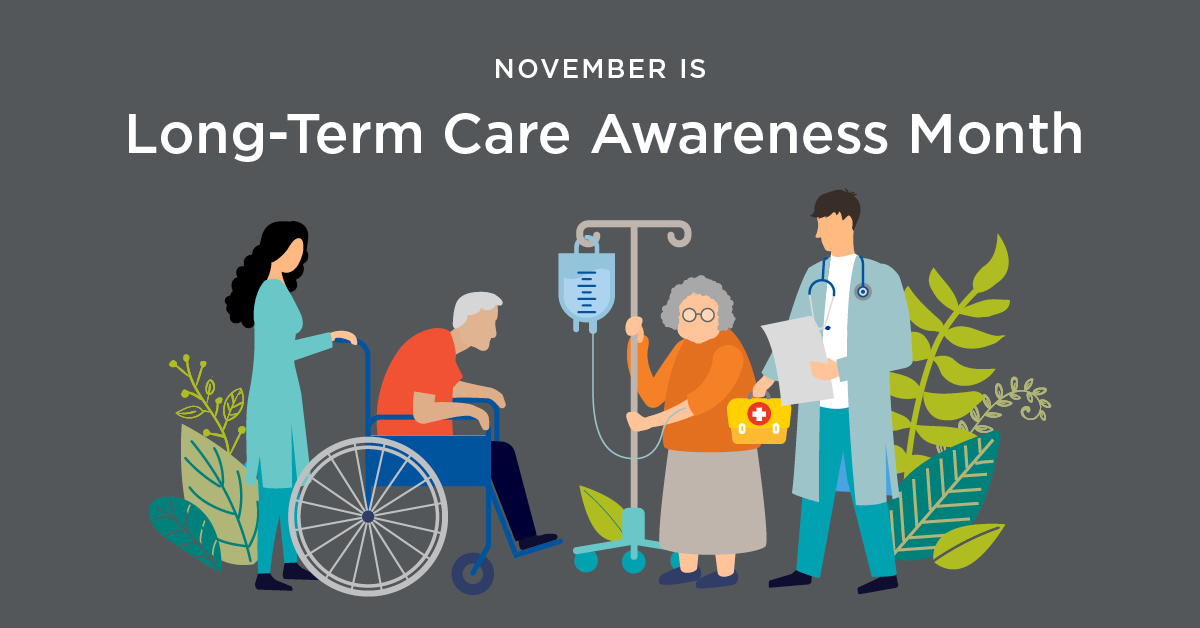10 Things to Know About Long-Term Care
It’s funny how when I came here 21 years ago from the Philippines, I did not even know what Thanksgiving Day was. Now I look forward to it come November. As a physical therapist and an insurance advisor, November has another significance- Long Term Care Awareness. I’d like to share ten facts you should know about long-term care. Find out why it’s important and what you can do below.
Top 10 Things to Know About Long-Term Care
November is National Long-Term Care Awareness Month, an event recognized by Congress and a number of States. Check out this other post about why this is important. To mark the occasion, here are 10 interesting facts shared by the American Association for Long-Term Care Insurance. Bear in mind that Medicare does not pay for long-term care. State Medicaid may not cover you either if you do not qualify.
1. Americans are living longer, in large part due to advances in medical care and public health. Life expectancy in the US for those reaching 65 was 20 years on average in 2019.
2. By 2030, one in five residents in the US will be age 65 or older.
3. The number of people in need of long-term support services (LTSS) in the United States is already at 14 million and is expected to grow to 27 million by 2050.
4. Average out-of-pocket costs are $140,000 for those individuals who utilize paid long-term support services (LTSS). Roughly 17 percent will spend over $100,000 on LTSS. Almost 9 percent will spend over $250,000 on LTSS.
5. By 2040, the total prevalence of Alzheimer’s disease and related dementias in the US is expected to approximately double from 7.2 million to nearly 13 million, with 8.5 million women and 4.5 million men expected to develop dementia.
“The COVID-19 pandemic has highlighted that adults with underlying medical conditions need choice and access to quality care, either at their home or in a community setting. Long Term Care insurance helps to provide financial coverage that can preserve a family’s finances, as well as the ability to choose a wider range of health care options and care settings“. -Joe Guyotte of NGL
6. For those requiring high levels of LTSS, individuals and families pay 55 percent of long-term care costs out of pocket.
7. Currently, the majority of older single-person households are female. Women comprised 74 percent of solo households aged 80 and over. That’s because women live longer than men.
8. Some 7.5 million Americans have some form of long-term care insurance. Two-thirds of all new individual long-term care insurance claims pay for care needed by women. Women typically need care for an average of 3.7 years, while men require it for 2.2 years. Therefore long-term care insurance costs more for women than for men.
9. The long-term care insurance industry paid out $11 billion in benefits to some 310,000 individuals with insurance protection in 2019. The number will increase each year as the current number of policyholders grows older and, as a result, are more likely to begin their claim.
10. 69.5 percent of new claims start after the policyholder reaches age 80. If you live a long life, you are very likely to need long-term care. You’ll be very glad you have a policy to pay benefits.
A big concern for Baby Boomers
The top financial concern for a quarter of Baby Boomers is paying for long-term care services if they can’t take care of themselves and more than a quarter of Millennials want to talk to an advisor about long-term care insurance, according to the 2021 Insurance Barometer Study that Life Happens and LIMRA conducted. However—and here’s the catch—only 18% of people own long-term care insurance.
Should you insure or self-insure for long-term care? Read this post.
How to make the most of Long-Term Care Awareness Month
1. It is never too early to start planning for long-term care. Insurance premiums tend to be lower when you start early. And if you are in your 50s and older, it is imperative that you look into it now, especially this month of November. Contact me to know your options.
2. Share this newsletter with friends and family to bring awareness on planning for Long Term Care. This can be a difficult subject to talk about between family members but you will be glad you did. Use this newsletter to open the dialogue. Remind them that Medicare and Medicaid may not cover their long-term care expenses and they can end up paying out of pocket.
Did you know I can help anyone in any of the 50 states? Even those with only an ITIN!

Experiencing a DBMDR-Death, Birth, Marriage, Divorce, or Retirement? I can help!
To find out more, schedule a meeting with me.
What Dignity Planning Means:
I help you plan to ensure you live in dignity throughout your life until your last breath.
Living in dignity means
- Being able to focus on getting better because money is not an issue
- Being able to live comfortably and pay your mortgage even if you’re sick and can’t work
- Being able to take care of your sick family member because you can afford not to work
- Being able to afford the best care even when not covered by health insurance
- Living a quality of life until your last days
- Continuing to take care of the people who matter most even after you’re gone or no longer can work

Ask Sheilla
Q: Long-term care insurance is very expensive. How does life insurance with living benefits compare?
A: Thank you for asking this question. Many are wondering about this. You are correct that long-term care insurance is expensive and fewer companies offer them now because of the rising cost of care. I’m sure you have heard that recently they have hiked up their premiums. LTC insurance tends to be stringent on how they pay out benefits or reimburse for care. They may have a daily or benefit limit and inflation protection.
Life insurance with living benefits, on the other hand, is more straightforward and can cost less. Living benefits, specifically the chronic illness rider will pay out from the death benefit if the covered individual becomes sick and need assistance in doing two out of six activities of daily living or need supervision due to cognitive impairment. The activities of daily living refer to dressing, bathing, toileting, transferring, eating, and continence.
Since life insurance premiums are based on age and health, the younger and healthier you are, the lower the premium. In addition to chronic illness, critical illness and terminal illness benefits are included without extra cost and are included on our term as well as permanent plans (whole life or universal life).
So when you purchase any life insurance from me, you are getting living benefits without paying extra premiums! Schedule a time to talk with me to see if this meets your needs.
Sheilla Vidal is a Retirement Income Certified Professional RICP® and life insurance broker. Sheilla is also a physical therapist, wife, mother of two, and one of the caregivers for her 85-year-old father. She is an avid learner. She writes, speaks, and recognizes that her work in helping clients live with dignity is her God-given mission.



